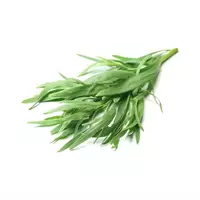Tarragon

For many, it may seem surprising, but a close relative of tarragon is wormwood. At the same time, tarragon does not have the very famous bitter taste that wormwood is famous for, and therefore is actively used for food purposes as a seasoning. In the wild, tarragon is often found in the vastness of Siberia, Mongolia, it can be found in some areas of Europe and the USA.
The origin of the plant name is also interesting. In translation, tarragon means "little dragon. " This can be related to two facts. First, tarragon has an unusual leaf shape - elongated, narrow and bifurcated. Secondly, perhaps the benefits of tarragon in the fight against snake bites are reflected here. Tarragon has a pronounced anti-inflammatory effect.
Benefits of tarragon
The useful properties of tarragon are not limited to this. The composition of the plant includes vitamins C, A, B, as well as significant amounts of iron, calcium, phosphorus and potassium. The essential oils of tarragon not only give it an amazing taste and aroma, but are also useful for many systems of the human body. Tarragon is able to arouse appetite, improve digestive processes. In addition, the benefits of tarragon in strengthening the nervous system, effective fight against stressful situations, restless sleep, headache have been proven.
Tarragon has an effective diuretic and worming effect. Tarragon tincture is recommended for arthritis, rheumatism, cystitis. External use of tarragon has also proven to be effective, in particular, in the fight against eczema, scabies and burns. Tarragon is a wonderful tool for strengthening vessels and the circulatory system as a whole. This spicy weed is also good for men's health.
Tarragon is indispensable in dietary nutrition. The calorie content of tarragon is about 25 kcal. 100 gr. When losing weight, as a rule, salt consumption is limited, tarragon in combination with other herbs can easily replace it. Thus, the problem of "tasteless" food is solved. For the same reason, it is important to use tarragon for people suffering from hypertension, for those who have been found to have kidney stones.
Tarragon turned out to be simply indispensable in cooking. It is used as a seasoning for meat and fish dishes, salads are added fresh. Tarragon is an excellent preservative, so it is actively used in various pickles and marinades. It is worth mentioning that another name for tarragon is tarhun. Yes, yes, it is he who is used to get the drink of the same name, famous for the whole world.
The harms of tarragon
Tarragon can only be harmed when consumed in large quantities, so moderation should be observed when using tarragon. In addition, tarragon is categorically contraindicated in pregnant women. It is thought he could trigger a miscarriage.
tarragon 24.8 kCal
Energy value of tarragon (Ratio of proteins, fats, carbohydrates - ju):
Proteins: 1.5 g (~ 6 kCal)
Fats: 0 g (~ 0 kCal)
Carbohydrates: 5g (~ 20kCal)
Energy ratio (bj | y): 24% | 0% | 81%
 Español
Español Français
Français Português
Português Русский
Русский 简体中文
简体中文 繁體中文
繁體中文 日本語
日本語 한국어
한국어 العربية
العربية Türkçe
Türkçe Қазақ
Қазақ Deutsch
Deutsch Italiano
Italiano Українська
Українська
